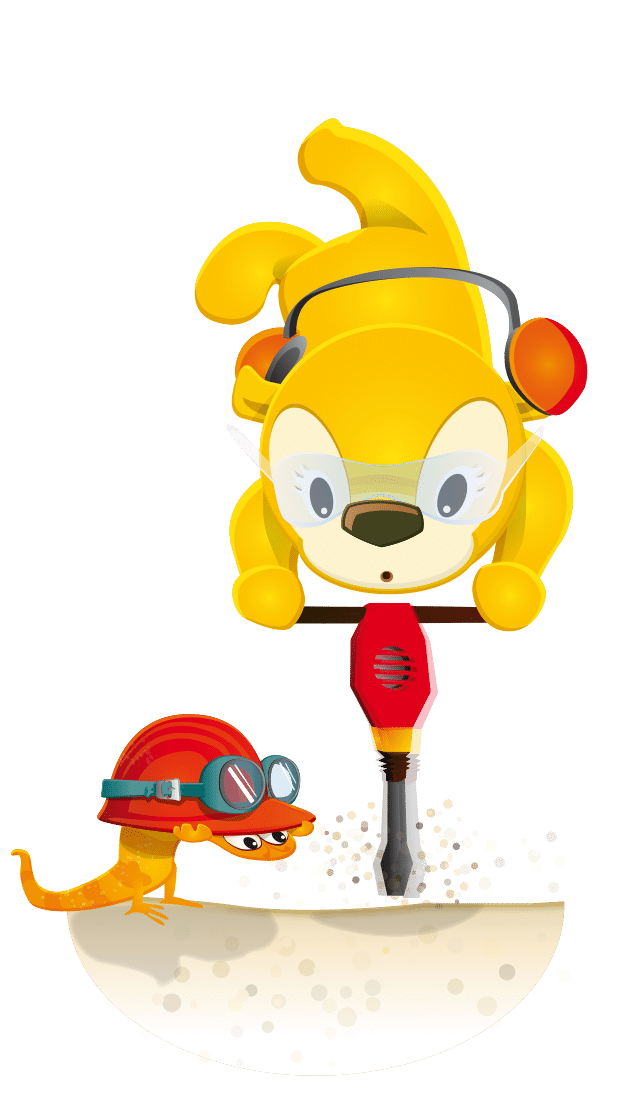

Dig, digging, done. Wombats having fun.
Wombi has an unstoppable desire to dig. He is not averse to heavy machinery either. His diligent digging often brings him unforeseen opportunities which are capitalised on by his entrepreneurial spirit – mostly. Wombi’s only problems arise when he is unable to dig for any length of time. He is a wombat after all.
Tools would come and tools would go but Wombi knew as wombats know that digging was the only thing that mattered
Wombi has built his home in what has become a large quarry to the east of the Bunyip Tree town where he can and does dig to his hearts content. With rail links to the main town and some carefully selected tools he is very well situated for a common wombat.
A good friend of Wombi, Izzie, is a Pygmy spiny-tailed skink. He helps out on some of Wombi’s bigger projects and ends up getting into many situations that he would not normally get into of his own volition. Izzie’s biggest problem is finding work gear that fits. Pygmy is not a usual size for workwear stockists.
Wombi started digging while he was still an infant. As with most wombats he began by using his own claws and helping to dig family burrows. Burrows are a good start for any young wombat and in fact many wombats never reach beyond the burrow stage of their digging development. Wombi, however, quickly saw the benefits of a career in digging and during his early schooling years became the master of such tools as the spade, shovel and mattock. Much admired by his classmates and encouraged by his teachers, Wombi completed his schooling and moved on to enter university and begin a course in mechanical engineering which he finished with honours.
Much of Wombi’s post university years are undocumented and unclear but persistent rumours exist of Wombi being employed for a short stint by a wealthy mining magnate who sent him to exotic destinations to dig out even more exotic minerals. These rumours may not be correct but they could explain how he was able to afford the parcel of land he bought and subsequently quarried which is his current home.

Wombi Power Chart
Learn About Wombats

The Common Wombat (Vombatus Ursinus)
The common wombat has short, slightly rounded ears, a large, hairless nose and coarse, thick fur. The pouch opens to the rear as an adaptation to ensure it does not fill with soil while the animal is digging. The rump is protected by bony plate and acts as a defensive shield if the wombat is chased down its burrow by a predator. Wombats are big, solid animals and adults may weigh in at over 30 kg.
Habitat: Wombats prefer the forests of temperate southeastern Australia, including alpine areas, although they will also inhabit coastal habitats and heathland. They live in burrows, which can be as long as twenty metres and may have several burrow systems that they use at different times. They prefer to dig their burrows in the slopes above creeks to safeguard against flooding.
Diet: Most of the diet comprises native grasses, herbaceous plants, and plant roots, which are located at night. A wombat may travel several kilometres each night in search of food.
Breeding: Wombats reach sexual maturity at the age of two years. There is no specific mating season. Usually only one young is born and it will remain in the pouch for around six months. However, the job does not end there as the juvenile will stay with the mother for almost another year.
Behaviour: Wombats are mostly nocturnal in summer, but may come out during the day in winter when temperatures are lower. They may share the use of their burrows with other wombats but usually only one is resident at a time. Although they are not territorial in their sleeping arrangements, they are territorial about feeding areas and will scent mark their territory or defend it aggressively.
For more information visit: The Australian Reptile Park



